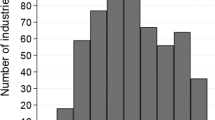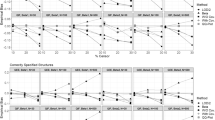Abstract
The reliability and validity of six experts’ exposure ratings were evaluated for 64 nickel-exposed and 72 chromium-exposed workers from six Shanghai electroplating plants based on airborne and urinary nickel and chromium measurements. Three industrial hygienists and three occupational physicians independently ranked the exposure intensity of each metal on an ordinal scale (1–4) for each worker’s job in two rounds: the first round was based on responses to an occupational history questionnaire and the second round also included responses to an electroplating industry-specific questionnaire. The Spearman correlation (rs) was used to compare each rating’s validity to its corresponding subject-specific arithmetic mean of four airborne or four urinary measurements. Reliability was moderately high (weighted kappa range=0.60–0.64). Validity was poor to moderate (rs=−0.37–0.46) for both airborne and urinary concentrations of both metals. For airborne nickel concentrations, validity differed by plant. For dichotomized metrics, sensitivity and specificity were higher based on urinary measurements (47–78%) than airborne measurements (16–50%). Few patterns were observed by metal, assessment round, or expert type. These results suggest that, for electroplating exposures, experts can achieve moderately high agreement and (reasonably) distinguish between low and high exposures when reviewing responses to in-depth questionnaires used in population-based case-control studies.
This is a preview of subscription content, access via your institution
Access options
Subscribe to this journal
Receive 6 print issues and online access
$259.00 per year
only $43.17 per issue
Buy this article
- Purchase on Springer Link
- Instant access to full article PDF
Prices may be subject to local taxes which are calculated during checkout

Similar content being viewed by others
References
Siemiatycki J, Day N, Fabry J, Cooper JA . Discovering carcinogens in the occupational environment: a novel epidemiologic approach. J Natl Cancer Inst 1981; 66: 217–225.
Stewart PA, Stewart WF, Siemiatycki J, Heineman EF, Dosemeci M . Questionnaires for collecting detailed occupational information for community-based case control studies. Am Ind Hyg Assoc J 1998; 59: 39–44.
Rybicki BA, Peterson EL, Johnson CC, Kortsha GX, Cleary WM, Gorell JM . Intra- and inter-rater agreement in the assessment of occupational exposure to metals. Int J Epidemiol 1998; 27: 269–273.
Benke G, Sim M, Forbes A, Salzberg M . Retrospective assessment of occupational exposure to chemicals in community-based studies: validity and repeatability of industrial hygiene panel ratings. Int J Epidemiol 1997; 26: 635–642.
Siemiatycki J, Fritschi L, Nadon L, Gérin M . Reliability of an expert rating procedure for retrospective assessment of occupational exposures in community-based case-control studies. Am J Ind Med 1997; 31: 280–286.
McGuire V, Longstreth WT, Nelson LM, Koepsell TD, Checkoway H, Morgan MS et al. Occupational exposures and amyotrophic lateral sclerosis. A population-based case-control study. Am J Epidemiol 1997; 145: 1076–1088.
Goldberg MS, Siemiatycki J, Gerin M . Inter-rater agreement in assessing occupational exposure in a case-control study. Br J Ind Med 1986; 43: 667–676.
Fritschi L, Nadon L, Benke G, Lakhani R, Latreille B, Parent ME et al. Validation of expert assessment of occupational exposures. Am J Ind Med 2003; 43: 519–522.
Friesen MC, Coble JB, Katki HA, Ji BT, Xue S, Lu W et al. Validity and reliability of exposure assessors’ ratings of exposure intensity by type of occupational questionnaire and type of rater. Ann Occup Hyg 2011; 55: 601–611.
Teschke K, Olshan AF, Daniels JL, De Roos AJ, Parks CG, Schulz M et al. Occupational exposure assessment in case–control studies: opportunities for improvement. Occup Environ Med 2002; 59: 575–594.
Tielemans E, Heederik D, Burdorf A, Vermeulen R, Veulemans H, Kromhout H et al. Assessment of occupational exposures in a general population: comparison of different methods. Occup Environ Med 1999; 56: 145–151.
Steinsvåg K, Bråtveit M, Moen BE, Kromhout H . Inter-rater agreement in the assessment of exposure to carcinogens in the offshore petroleum industry. Occup Environ Med 2007; 64: 582–588.
Rocheleau CM, Lawson CC, Waters MA, Hein MJ, Stewart PA, Correa A et al. Inter-rater reliability of assessed prenatal maternal occupational exposures to solvents, polycyclic aromatic hydrocarbons, and heavy metals. J Occup Environ Hyg 2011; 8: 718–728.
Mannetje A, Fevotte J, Fletcher T, Brennan P, Legoza J, Szeremi M et al. Assessing exposure misclassification by expert assessment in multicenter occupational studies. Epidemiology 2003; 14: 585–592.
Post V, Kromhout H, Heederik D, Noy D, Duilzentkunst RS . Semiquantitative estimates of exposure to methylene chloride and styrene: the influence of quantitative exposure data. Appl Occup Environ Hyg 1991; 6: 197–204.
Teschke K, Hertzman C, Dimich-Ward H, Ostry A, Blair J, Hershler R . A comparison of exposure estimates by worker raters and industrial hygienists. Scand J Work Environ Health 1989; 15: 424–429.
Hertzman C, Teschke K, Dimich-Ward H, Ostry A . Validity and reliability of a method for retrospective evaluation of chlorophenate exposure in the lumber industry. Am J Ind Med 1988; 14: 703–713.
Guillemin MP, Berode M . A study of the difference in chromium exposure in workers in two types of electroplating process. Ann Occup Hyg 1978; 21: 105–112.
Kiilunen M, Utela J, Rantanen T, Norppa H, Tossavainen A, Koponen M et al. Exposure to soluble nickel in electrolytic nickel refining. Ann Occup Hyg 1997; 41: 167–173.
Pierre F, Diebold F, Baruthio F . Biomonitoring of two types of chromium exposure in an electroplating shop. Int Arch Occup Environ Health 2008; 81: 321–329.
Lumens ME, Ulenbelt P, Géron HM, Herber RF . Hygienic behaviour in chromium plating industries. Int Arch Occup Environ Health 1993; 64: 509–514.
Tola S, Kilpio J, Virtamo M . Urinary and plasma concentrations of nickel as indicators of exposure to nickel in an electroplating shop. J Occup Med 1979; 21: 184–188.
Liu CS, Kuo HW, Lai JS, Lin TI . Urinary N-acetyl-beta-glucosaminidase as an indicator of renal dysfunction in electroplating workers. Int Arch Occup Environ Health 1998; 71: 348–352.
Caglieri A, Goldoni M, Acampa O, Andreoli R, Vettori MV, Corradi M et al. The effect of inhaled chromium on different exhaled breath condensate biomarkers among chrome-plating workers. Environ Health Perspect 2006; 114: 542–546.
Bavazzano P, Bolognesi R, Cassinelli C, Gori R, Li Donni V, Martellini F et al. Skin contamination and low airborne nickel exposure of electroplaters. Sci Total Environ 1994; 155: 83–86.
Makinen M, Linnainmaa M . Dermal exposure to chromium in electroplating. Ann Occup Hyg 2004; 48: 277–283.
NIOSH. Manual of Analytical Methods (NMAM): Method 7300 4th edn US Department of Health and Human Services: Cincinnati, OH, USA. 1994.
NIOSH. Manual of Analytical Methods (NMAM): Method 8310 4th edn US Department of Health and Human Services: Cincinnati, OH, USA. 1994.
Smith TJ, Kriebel D . A Biologic Approach to Environmental Assessment and Epidemiology. Oxford University Press: New York, NY, USA. 2010 pp 77–79.
Landis JR, Koch GG . The measurement of observer agreement for categorical data. Biometrics 1977; 33: 159–174.
Ciccone G, Vineis P . Inter-rater agreement in the assessment of occupational exposure to herbicides. Med Lav 1988; 79: 363–367.
Correa A, Min YI, Stewart PA, Lees PS, Breysse P, Dosemeci M et al. Inter-rater agreement of assessed prenatal maternal occupational exposures to lead. Birth Defects Res A Clin Mol Teratol 2006; 76: 811–824.
Cherrie JW, Schneider T . Validation of a new method for structured subjective assessment of past concentrations. Ann Occup Hyg 1999; 43: 235–245.
de Cock J, Kromhout H, Heederik D, Burema J . Experts’ subjective assessment of pesticide exposure in fruit growing. Scand J Work Environ Health 1996; 22: 425–432.
Semple SE, Proud LA, Tannahill SN, Tindall ME, Cherrie JW . A training exercise in subjectively estimating inhalation exposures. Scand J Work Environ Health 2001; 27: 395–401.
Vermeulen R, Stewart P, Kromhout H . Dermal exposure assessment in occupational epidemiologic research. Scand J Work Environ Health 2002; 28: 371–385.
Bakke B, Stewart PA, Waters MA . Uses of and exposure to trichloroethylene in U.S. industry: a systematic literature review. J Occup Environ Hyg 2007; 4: 375–390.
Park D, Stewart PA, Coble JB . A comprehensive review of the literature on exposure to metalworking fluids. J Occup Environ Hyg 2009; 6: 530–541.
Pronk A, Coble J, Stewart PA . Occupational exposure to diesel engine exhaust: a literature review. J Expo Sci Environ Epidemiol 2009; 19: 443–457.
Lavoue J, Friesen MC, Burstyn I . Workplace measurements by the US Occupational Safety and Health Administration since 1979: descriptive analysis and potential uses for exposure assessment. Ann Occup Hyg 2013; 57: 77–97.
Froines JR, Baron S, Wegman DH, O’Rourke S . Characterization of the airborne concentrations of lead in U.S. industry. Am J Ind Med 1990; 18: 1–17.
Friesen MC, Coble JB, Lu W, Shu XO, Ji BT, Portengen L et al. Combining a job-exposure matrix with exposure measurements to assess occupational exposure to benzene in a population cohort in Shanghai, China. Ann Occup Hyg 2012; 56: 80–91.
Burstyn I, Jonasi L, Wild TC . Obtaining compliance with occupational health and safety regulations: a multilevel study using self-determination theory. Int J Environ Health Res 2010; 20: 271–287.
Koh DH, Bhatti P, Coble JB, Stewart PA, Lu W, Shu XO et al. Calibrating a population-based job-exposure matrix using inspection measurements to estimate historical occupational exposure to lead for a population-based cohort in Shanghai, China. J Expo Sci Environ Epidemiol 2014; 24: 9–16.
Peters S, Vermeulen R, Olsson A, Van Gelder R, Kendzia B, Vincent R et al. Development of an exposure measurement database on five lung carcinogens (ExpoSYN) for quantitative retrospective occupational exposure assessment. Ann Occup Hyg 2012; 56: 70–79.
Stewart PA, Carel R, Schairer C, Blair A . Comparison of industrial hygienists’ exposure evaluations for an epidemiologic study. Scand J Work Environ Health 2000; 26: 44–51.
Pronk A, Stewart PA, Coble JB, Katki HA, Wheeler DC, Colt JS et al. Comparison of two expert-based assessments of diesel exhaust exposure in a case–control study: programmable decision rules versus expert review of individual jobs. Occup Environ Med 2012; 69: 752–758.
Kromhout H, Oostendorp Y, Heederik D, Boleij JS . Agreement between qualitative exposure estimates and quantitative exposure measurements. Am J Ind Med 1987; 12: 551–562.
Logan P, Ramachandran G, Mulhausen J, Hewett P . Occupational exposure decisions: can limited data interpretation training help improve accuracy? Ann Occup Hyg 2009; 53: 311–324.
Acknowledgements
This study was funded by the Intramural Research Program of the Division of Cancer Epidemiology and Genetics, National Cancer Institute, National Institutes of Health.
Author information
Authors and Affiliations
Corresponding author
Ethics declarations
Competing interests
The authors declare no conflict of interest.
Additional information
Supplementary Information accompanies the paper on the Journal of Exposure Science and Environmental Epidemiology website
Supplementary information
Rights and permissions
About this article
Cite this article
Chen, YC., Coble, J., Deziel, N. et al. Reliability and validity of expert assessment based on airborne and urinary measures of nickel and chromium exposure in the electroplating industry. J Expo Sci Environ Epidemiol 24, 622–628 (2014). https://doi.org/10.1038/jes.2014.22
Received:
Accepted:
Published:
Issue Date:
DOI: https://doi.org/10.1038/jes.2014.22
Keywords
This article is cited by
-
Evaluation of airborne total suspended particulates and heavy metals in anodizing and electroplating surface treatment process
Scientific Reports (2021)
-
Using Decision Rules to Assess Occupational Exposure in Population-Based Studies
Current Environmental Health Reports (2019)



